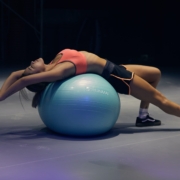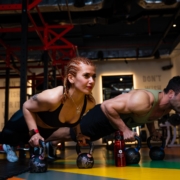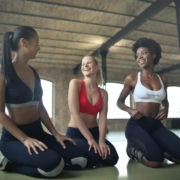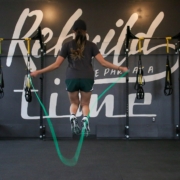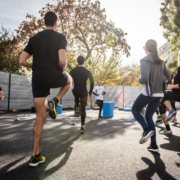When it comes to building muscle and getting stronger, proper nutrition is essential. Here are some nutrition rules to follow to support your muscle-building goals:
- Eat Enough Protein: Protein is essential for building and repairing muscle tissue. Aim to eat a protein-rich food source with every meal, such as lean meats, fish, eggs, tofu, or legumes. A general guideline is to aim for 1-1.5 grams of protein per pound of body weight per day.
- Include Complex Carbohydrates: Carbohydrates are an important energy source for workouts, and complex carbohydrates such as whole grains, fruits, and vegetables can provide sustained energy throughout the day. Aim for a balance of complex carbohydrates and protein in your meals.
- Don’t Forget Healthy Fats: Healthy fats such as nuts, seeds, avocado, and olive oil can help to support hormone function and provide energy. However, be mindful of portion sizes, as fats are higher in calories.
- Stay Hydrated: Water is essential for overall health and hydration is especially important for supporting physical activity. Aim to drink at least 8-10 cups of water per day, and more if you are engaging in intense exercise.
- Consider Timing and Quantity: Eating small, frequent meals throughout the day can help to support muscle-building goals, as can eating a post-workout meal that contains both protein and carbohydrates to aid in recovery.
Remember, nutrition is just one piece of the puzzle when it comes to building muscle and getting stronger. Consistent exercise, including strength training, is also essential for achieving these goals. Additionally, it’s important to listen to your body and make adjustments to your nutrition and exercise routine as needed to support your overall health and wellness.
Building muscle calls for a superb power stability, this means that which you should absorb greater energy than you burn. You want more or less 2,800 energy to construct a pound of muscle, in large part to aid protein turnover, which may be accelerated with education. By following those 8 guidelines, you’ll be capable of construct muscle groups greater effectively and speedy.
Your frame can construct at maximum round approximately 227g of muscle every week, so in case you consume too many more energy looking to construct greater muscle, you may benefit extra fats, too. We could propose eating a further 250 to 500 energy in keeping with day. If you benefit fats easily, live at the decrease quit of the range, and in case you locate it hard to benefit weight in general, purpose for the better quit of the range. It will take a piece of trial and mistakess to locate the proper quantity of extra energy to construct muscle and live lean.
In addition, studies shows that eating lean protein 15 to twenty mins before, throughout and inside one hour of running out can also additionally assist enhance muscle benefit. Since you’re possibly now no longer going to be ingesting a steak or bird breast on the gym, a protein drink or complement can be useful straight away before, throughout or after exercises, however isn’t essential. However, it’s now no longer all approximately protein. It’s approximately ingesting many food that meet your calorific expenditure and offer you with the vitamins as a part of a wholesome, balanced weight loss plan to help you to construct muscle, lose fats and get stronger. Here are 8 easy guidelines that will help you get on track…
1. EAT BREAKFAST TO HELP BUILD MUSCLE MASS This offers you a right away burst of power and lets you live complete till your subsequent meal or snack. It additionally units the trend: you’ll have a tendency to consume more healthy in case your day begins offevolved with a robust and wholesome breakfast. Your satisfactory bets in case your looking to construct muscle groups are omelettes, smoothies and cottage cheese.
2. EAT EVERY THREE HOURS Eating the proper aspect on the proper time is important for supporting you raise your muscle groups. The simplest manner is to consume your breakfast, lunch and dinner as usual, interspersed with food put up exercise, pre-mattress and with snacks in between. By preserving your meals consumption up, it’ll suggest you won’t be as hungry, due to the fact ingesting smaller food greater frequently as opposed to some huge food will lower your belly size. You’ll experience complete greater speedy and your waist will trim, even as you’ll additionally have fewer cravings. Not ingesting for lengthy intervals can reason you to over-consume at the following meal or topping your self up with dangerous snacks from the merchandising machine. So to forestall any cravings, consume at constant instances each day and your frame gets hungry at the ones constant instances.
3. EAT PROTEIN WITH EACH MEAL TO BOOST YOUR MUSCLE MASS You want protein to construct and keep muscle. To obtain this, you must be seeking to consume at the least 1g in keeping with 454g of frame-weight. That’s 200g/day in case you weigh 91kg. The simplest manner to get this quantity is to consume an entire protein supply with every meal. These include:
• Red meat. Beef, pork, lamb, etc.
• Poultry. Chicken, turkey, duck, etc.
• Fish. Tuna, salmon, sardines, mackerel, etc.
• Eggs. Don’t agree with the ldl cholesterol myths. Eat the yolk.
• Dairy. Milk, cheese, cottage cheese, quark, yogurt, etc.
• Whey. Not essential however fantastic for smooth put up exercise shakes.
• Try vegan alternatives too, which include lentils, tofu, seeds and nuts.
4. EAT FRUIT AND VEGETABLES WITH EACH MEAL Most of them (now no longer all) are low calorie: you may consume your belly complete with out gaining fats or weight. Fruit and greens also are complete of vitamins, minerals, antioxidants and fibre which enables digestion, however simply be cautious to test the sugar content material of a few fruits.
5. EAT CARBS ONLY AFTER YOUR WORKOUT While you want carbs for power, maximum humans consume greater than they want. Limit your carbohydrate consumption to after your exercise only. • Eat fruit and greens with all food. These comprise few carbohydrates in comparison to entire grains apart from corn, carrots and raisins. • Another Carbs Post Workout Only. This is rice, pasta, bread, potatoes, quinoa, oats, etc. Avoid white carbs and consume entire grain.
6. EAT HEALTHY FATS Healthy fat enhance fats loss and fitness as they digest slowly. Make certain you stability your fats consumption, consume wholesome fat with each meal and keep away from synthetic trans-fat and margarine.
7. DRINK WATER TO HELP YOU BUILD MUSCLE MASS Strength education reasons water loss thru sweating which could impair muscle healing and thus, it won’t assist you growth your muscle groups. Drinking water prevents dehydration however additionally starvation when you consider that an empty belly could make you observed you’re hungry.
8. EAT WHOLE FOODS 90% OF THE TIME To truely get the outcomes you need and to enhance your muscle groups significantly, 90% of your meals consumption must encompass entire ingredients.
• Whole ingredients. These are unprocessed and unrefined (or little refined) ingredients that come as near as viable to their herbal state. Examples: sparkling meat, fish, poultry, eggs, greens, pulses, fruits, rice, oats, quinoa etc.
• Processed ingredients Usually comprise introduced sugars, trans-fat, nitrates, corn syrup, sodium and greater chemicals. Examples: bagels, fruit bars, cereals, pizza, cookies, sausages, frozen food, supplements.


